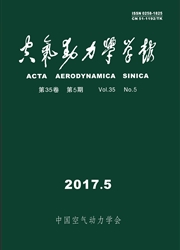

 中文摘要:
中文摘要:
在干扰剪切流(Interacting Shear Flow,ISF)理论的基础上,提出ISF稳定性理论并把它用于改进高雷诺(Rs)数流动计算方法。(1)高Re数内外绕流的RANS计算及工业标准PNS计算中,流动转捩的预测均基于经典边界层理论;然而转捩并非总是最早发生在边界层中,例如发生在壁面小突起、小凹坑、小窄缝等局部粘性/无粘强干扰区,这些强干扰区可能位于边界层内,但边界层理论并不适用于它们,又如转捩发生在分离点邻域强干扰区等。(2)ISF理论表明:高Re数内外绕流为一复杂ISF,转捩总是最早发生在该ISF的层流区中。(3)ISF稳定性理论表明:作者提出的干扰剪切扰动流(Interacting Shear Perturbed Flow,ISPF)方程组可以计算ISF层流中非湍流扰动运动演化并预测转捩;ISF方程组和1SPF方程组分别与PNS和抛物化稳定性方程(PSE)为同类方程组,PSE分析计算边界层稳定性的众多成功实践,说明用ISPF(即PSE)方程组计算ISF层流扰动流并预测转捩完全可行。(4)RANS和PNS方法经ISF稳定性理论改进后,在转捩前用ISF方程组(即PNS)计算ISF层流基本流,用IS—PF方程组(即PSE)计算ISF层流扰动流并预测转捩位置;转捩后RANs方法计算RANS或RANS/LES,PNS方法计算干扰剪切湍流(ISTF)方程组即抛物化RANS(PRANs)方程组。改进后的两方法,理论合理正确,方程体系完备、自洽,ISF方程组只能用ISPF方程组相配对,因此是高Re数内外绕流计算的理想且可持续发展的两种方法。
 英文摘要:
英文摘要:
On the basis of the interacting shear flow (ISF) theory proposed by the author, the ISF stability theory and its two inferences with application to improving computational meth- ods of simulating numerically high Reynolds (Re) number inner/outer flows are presented in this paper. (1) In the RANS computations and an industry-standard PNS computations for high Reynolds number flows over bodies, predicting transition is always based on the classical bounda- ry-layer theory coupled with experimental data; however, transition does not always occur origi- nally in boundary-layer, initial transition may occur in dents, or small step or small cracks at wall, these local strong interaction flow regions may locate in boundary layer, but boundary-layer theory is not suitable for these flow regions, and transition occurs in strong interaction flow re- gion near separation point etc. (2) Flow transition occurs always in interacting shear flow, ISF theory extracted by the author is composed of viscous shear layer and its neighbor outer inviscidflow with interaction each other ISF summarizes many viscous-inviscid flows with basis mean- ings and engineering values, two typical example of ISF are the classical viscous boundary layer added its neighbor outer inviscid flow, and the viscous/inviscid flow near wall in high Re number inner/outer flows over bodies. (3) The interacting shear perturbed flow (ISPF) equations offer new theoretical computational method to simulate non-turbulence perturbed motion and transition in ISF. The ISF- equations and ISPF equations are respectively the same kind of PNS- and PSE- equations. Many works of using PSE analyses and computes boundary-layer stability show that it is perfectly feasible to compute perturbed flow of ISF and predict transition using ISPF (or PSE) equations. (4) The computational results given by solving simultaneously ISF- and ISPF equa- tions are reasonable approximation of the direct numerical simulation (DNS) of ISF before transi- tion. (
 同期刊论文项目
同期刊论文项目
 同项目期刊论文
同项目期刊论文
 期刊信息
期刊信息
